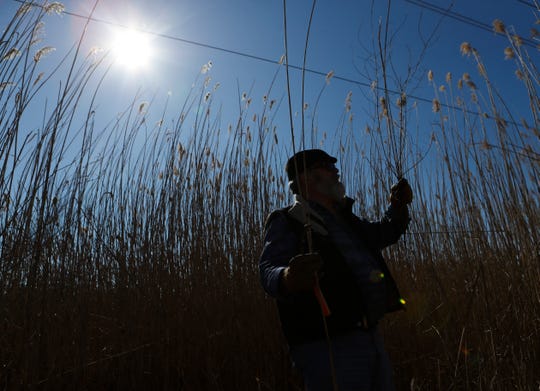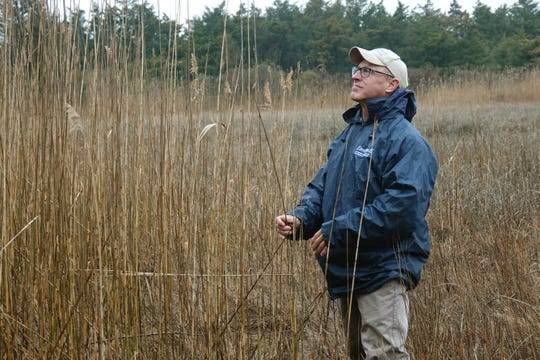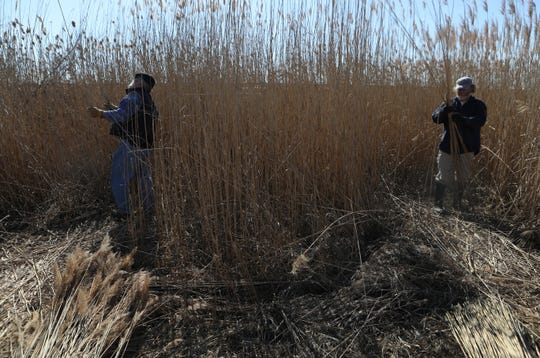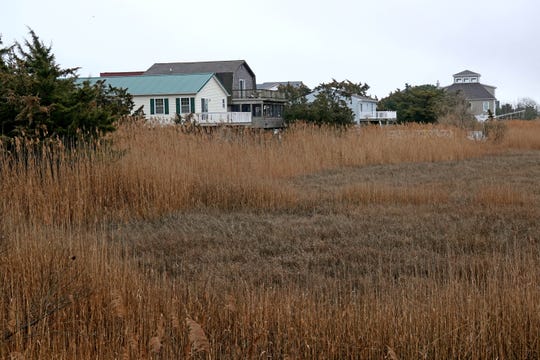Could climate change shift the conversation on this invasive species?
[This article was originally published by The Delaware News Journal in partnership with WHYY.]
On some summer mornings during Delaware’s prime beach season, Todd Fritchman can be spotted running along the sandy shores of the Atlantic Ocean or coaching squads of Baywatch look-a-likes on rip currents and rescues in Dewey Beach.
But when his towel is hanging up for the day, he might be found waging a war that’s decades in the making against one of the region’s most invasive coastal species.
And no, they’re not tourists.
His deep-rooted adversary is an invasive strain of Phragmites australis, a fluffy-topped marsh reed that has been decried as a destroyer of habitat. A blocker of views. Kindling just waiting to catch a flame.
“There’s so much negativity to it,” Fritchman said. “We shouldn’t be considering preserving or conserving it in any way, in my opinion.”
But the war against phragmites may not be as black and white as it was back in 1984 when the Delaware General Assembly dubbed the reeds a public nuisance, or even in the ‘90s when Fritchman founded Envirotech Environmental Consulting Inc. and took his herbicides to battle.
Some scientists have been arguing that phragmites – also known as common reed or just “Phrag” – could be a key line of defense against rising sea level, particularly in areas like the Mid-Atlantic where land is sinking while water continues to rise.
Research from 20 years ago found that phragmites help marshes elevate faster than some other plants, said Rutgers University professor emeritus Judith Weis.
“But the management of the marshes and the removal of Phrag continues on unaffected by all the science that’s gone on about it,” the marine biologist said. “Well, might I say…there’s a whole army of environmental consultants that get paid to remove phragmites and don’t get paid to leave it alone.”
With hundreds of thousands of state and federal dollars already spent on managing this invasive strain of phragmites in Delaware alone, whether the conversation shifts on how the plants are viewed totally depends on perspective, some experts say.
“I see a dichotomy between folks that are a little more research-based, more scientific, and then those that are focused on management,” said LeeAnn Haaf, wetland coordinator at the Partnership for the Delaware Estuary. “And it’s not the only example of management and science not having the same opinion.”
As he weaved his way through an overwhelmingly monotone wall of phragmites on the edges of Prime Hook National Wildlife Refuge, Fritchman largely snubbed the idea that the plant he’s been fighting for the last 30 years could have any redeeming qualities.
To him, the phragmites takeover has turned something that was once full of varied life and native plants like saltmarsh cordgrass into a barren, tan wasteland devoid of bird song.
“Rarely in nature is something ever 100 percent bad,” said Delaware Sen. Stephanie Hansen, D-Middletown, who recently introduced legislation that would ban the sale of invasive plants like Phragmites australis in Delaware. “We just have to be smart and wise about what we’re really able to control when Mother Nature is involved.”
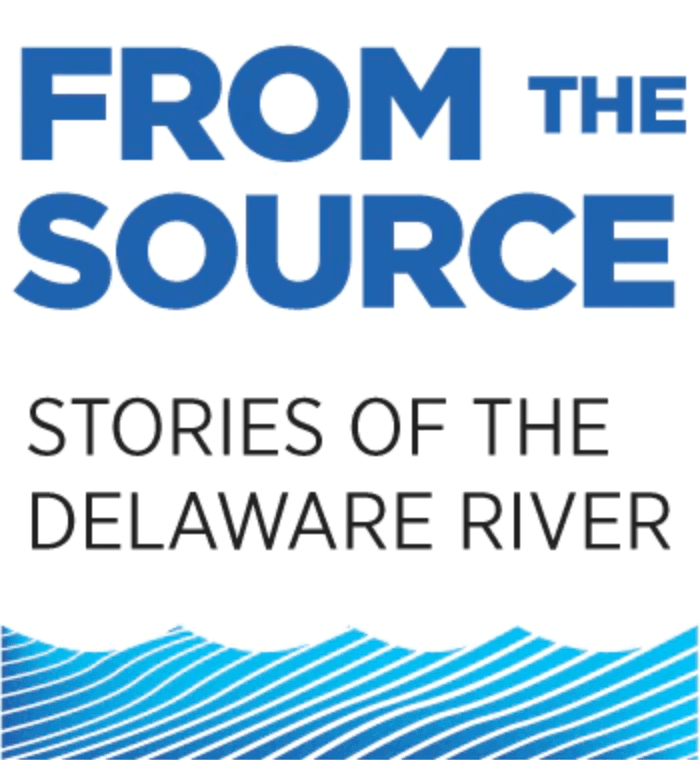
A creative way to look at phragmites
Winters along the Delaware River and its tributaries can lead to picturesque scenes of snow-topped phragmites swaying in the wind. This winter may not have offered many chances to soak in that scene, but it did provide a group of local artists an opportunity to look at the reeds in a different way.
Earlier this year, among the marshes at the John Heinz National Wildlife Refuge in Philadelphia and near the DuPont Environmental Education Center along the Wilmington Riverfront, local artists trekked into thick stands of phragmites and carefully sawed down swaths of the oft-hated plants.
Among the defeated reeds, artist Sarah Kavage recalled how the reeds are used to thatch roofs on English or Irish cottages, or used to build whole houses for specific ceremonies in southern Iraq, where they’re not considered invasive.
Artist Sarah Kavage poses for a photo at the John Heinz National Wildlife Refuge at Tinicum on February 8, 2020. Kavage hosted a harvesting session at Tinicum called Phrag Fest in which volunteers came together to harvest invasive Phragmites reed, which will be used to create large scale outdoor art at sites across the region. (Rachel Wisniewski for WHYY)
“The reeds that we gather will be used to make sort of different types of structures that will be kind of sculptural gathering areas at different sites all over the region,” she said.
The Phrag-based works are expected to appear in Philadelphia, Camden and Wilmington areas along the water.
For Heinz refuge manager Lamar Gore, the marshes he manages are keeping pace with sea-level rise, thanks in part to sediment flowing downstream, he said. The negative aspects of phragmites – how they overtake marshes, push out native plants and leave behind a maze of tight-knit reeds that many marsh species avoid – remain the bigger issue.
“I think every manager has to take a look at that and see what the balance is,” Gore said, noting that about 30 percent of the refuge he manages near Philly is covered by Phrag. “It’s a constant battle.”
Refuge manager Lamar Gore poses for a photo at the John Heinz National Wildlife Refuge at Tinicum on February 8, 2020. Gore oversaw volunteers harvesting the invasive Phragmites reed at Tinicum, which will be used to create large scale outdoor art at sites across the region. (Rachel Wisniewski for WHYY)
or Ian Stewart, an ornithologist at the Delaware Nature Society, the habitat loss created by the invasive reeds – which emit a toxin that drives out the native competition like Spartina alterniflora, switchgrass and asters – coupled with sea-level rise means huge problems for some of the rarest bird species, like the saltmarsh sparrow, seaside sparrow, willet and three types of rails.
“You should care because birds are very much indicators of how healthy the climate is,” he said. “If the birds start declining, it’s a bigger indicator that everything else is declining, too.”
Fighting a losing battle?
How much invasive phragmites could help the Delaware Estuary in the face of rising sea level remains to be seen.
So far, said Haaf, the wetland coordinator, many marshes linked to the Delaware River are keeping pace.
Whether they start to lose the race against rising sea level in 50 years or 100 years is one question scientists can’t answer yet, she said.
In the Mid-Atlantic, scientists have found that sea-level rise combined with land subsidence means the region is seeing sea level rise at least twice the global average.
Along the Delaware River, that means high tides are getting higher, particularly in more northern and narrow reaches of the waterway, Haaf said.
“We’re all connected by this flow of water,” she said. “And the fact that that’s changing because of climate, that’s really important for water resources and our own health.”
The herbicide treatment of phragmites can also mean other native plants become casualties in the process, leaving an unvegetated landscape behind. With no plants to hold sediment in place, an open mudflat can be extremely vulnerable to flooding in the face of storms or unsuccessful regrowth.
High school students volunteering with Mobilize Green harvest the invasive Phragmites reed at John Heinz National Wildlife Refuge at Tinicum on February 8, 2020. The harvesting session, called Phrag Fest, kicks off an ecological art project by artist Sarah Kavage (not pictured). (Rachel Wisniewski for WHYY)
Rutgers’ Weis says that while phragmites does produce a monoculture that limits biodiversity, in some cases it would help prevent the salt marsh from disappearing. That’s because in urban or developed areas, there would be no place for the salt marsh to migrate in the face of sea level rise, leaving properties now protected by the marsh right up against open water.
“You know, the Phrag marsh is certainly a whole lot better than no marsh,” she said.
Meanwhile, other studies have found that phragmites are also skilled at trapping harmful pollutants, like toxic metals and gases, much better than favored native plants because of their extensive underground root system.
While there is a native phragmites, the invasive one is much more widespread. It can be seen along waterways, forests and fields around the world, on higher swaths of land along freshwater and brackish water sources.
That could mean that killing colonies of phragmites could potentially release carbon or the toxic metals they were keeping from reaching local waterways, Haaf and Weis said.
“We shouldn’t be killing it everywhere,” Weis said.
Delaware officials agree. Throughout the watershed, management decisions seem to be a balancing act: biodiversity weighed against the plant’s ability to soak up pollutants or stave off erosion.
In New Jersey, the energy company PSEG has lodged a decades long battle against phragmites growing along the Delaware Bay and its tributaries. PSEG owns the Salem nuclear plant, and as part of its environmental permit committed to removing phragmites and restoring native salt marsh plants on 10,000 acres of wetland.
But the plant’s invasion is still dubbed as one that has “caused the single greatest negative impact to thousands of acres of coastal wetlands,” according to Delaware environmental officials.
The future of Phrag
As artists collected dead reeds for future masterpieces, they made sure to contain the delicate seed pods at the top. Fritchman, the environmental consultant from southern Delaware, was relieved to hear that.
All phragmites seeds need to do is to catch a ride with the wind and land on some moist, fertile ground in order to take over an entire area, experts said.
Fritchman decries misnomers that phragmites are impossible to treat. They’re easy to treat, he says – if it’s done the right way.
That usually means calculated applications of systemic herbicides that poison the feet-long roots of the plant, the only successful way to kill it, managers say.
That process is typically done during summer months and often followed up with burning or mowing of the leftover dead stalks. And as Weis suggests, that approach shouldn’t – and isn’t – applied everywhere.
“We’ve recognized those potential benefits regarding erosion and have adapted our control program,” said DNREC Division of Fish & Wildlife Regional Manager Bill Jones. “Where we have kept up with treatments, we have successfully brought areas back to a more diverse marsh.”
Fritchman said he’s also gained ground against phragmites in some heavily managed places, bringing hope that his efforts could restore the native food sources and habitats for global species – like migrating birds that also attract nature tourism visitors to Delaware’s Bayshore vistas.
Standing along Broadkill Road and looking south toward the beach homes that line Broadkill Beach, he also noted how close people’s back steps were to the dried out reeds creeping slowly into the mix. The thought of a spark catching those reeds and engulfing the houses next to the marsh is another reason he keeps fighting phragmites, he said.
The risk that comes with applying broad-range herbicides like glyphosate, a main ingredient in Monsanto’s Roundup, in sensitive coastal ecosystems is part of the trade-off of preserving habitat that land managers have to weigh.
“Unfortunately, my own feeling is that it’s the lesser of two evils,” said Stewart, the Delaware-based ornithologist.
The safety of those applications, done by helicopter in Delaware, are ensured by state and federal regulations and close adherence to product labels, Jones said. Killing off the phragmites gives other native plants a chance to recolonize, and the places treated like that are chosen carefully.
For scientists who are more focused on protecting the physical properties of coastal marshes, which can capture pollution and act like sponges during flooding events, the fight against Phrag is not often worth the risk. That particularly goes for places that could lose sediment and elevation if the reeds weren’t helping trap it all in place.
“It is reducing plant diversity, which is not something to just shrug your shoulders at,” said Weis. “But in my opinion, the ‘good things’ it does are more important currently because of climate change and sea level rise and pollution.”
Still, Fritchman and many other land managers in the watershed aren’t giving up their ground as they fight in favor of the biodiversity that phragmites is suffocating along the coast.
“Phragmites is one [invasive plant] where, if you don’t control it, you will lose all your native habitats,” said Gore, the manager from the Philadelphia-area refuge. “That’s one that I think folks will always try to control.”

